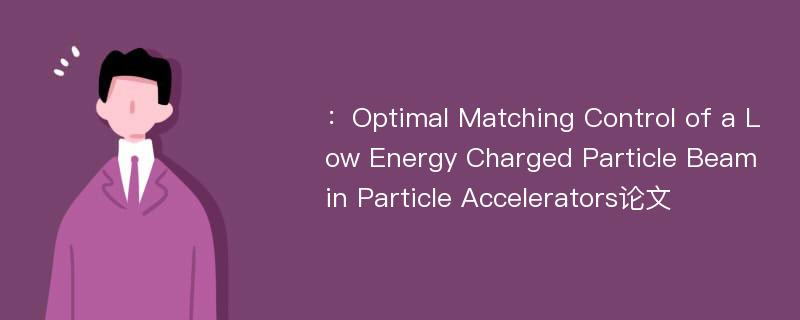
本文主要研究内容
作者(2019)在《Optimal Matching Control of a Low Energy Charged Particle Beam in Particle Accelerators》一文中研究指出:Particle accelerators are devices used for research in scientific problems such as high energy and nuclear physics.In a particle accelerator, the shape of particle beam envelope is changed dynamically along the forward direction. Thus, this reference direction can be considered as an auxiliary "time" beam axis. In this paper, the optimal beam matching control problem for a low energy transport system in a charged particle accelerator is considered. The beam matching procedure is formulated as a finite "time" dynamic optimization problem, in which the Kapchinsky-Vladimirsky(K-V) coupled envelope equations model beam dynamics. The aim is to drive any arbitrary initial beam state to a prescribed target state, as well as to track reference trajectory as closely as possible, through the control of the lens focusing strengths in the beam matching channel. We first apply the control parameterization method to optimize lens focusing strengths, and then combine this with the time-scaling transformation technique to further optimize the drift and lens length in the beam matching channel. The exact gradients of the cost function with respect to the decision parameters are computed explicitly through the state sensitivity-based analysis method. Finally, numerical simulations are illustrated to verify the effectiveness of the proposed approach.
Abstract
Particle accelerators are devices used for research in scientific problems such as high energy and nuclear physics.In a particle accelerator, the shape of particle beam envelope is changed dynamically along the forward direction. Thus, this reference direction can be considered as an auxiliary "time" beam axis. In this paper, the optimal beam matching control problem for a low energy transport system in a charged particle accelerator is considered. The beam matching procedure is formulated as a finite "time" dynamic optimization problem, in which the Kapchinsky-Vladimirsky(K-V) coupled envelope equations model beam dynamics. The aim is to drive any arbitrary initial beam state to a prescribed target state, as well as to track reference trajectory as closely as possible, through the control of the lens focusing strengths in the beam matching channel. We first apply the control parameterization method to optimize lens focusing strengths, and then combine this with the time-scaling transformation technique to further optimize the drift and lens length in the beam matching channel. The exact gradients of the cost function with respect to the decision parameters are computed explicitly through the state sensitivity-based analysis method. Finally, numerical simulations are illustrated to verify the effectiveness of the proposed approach.
论文参考文献
论文详细介绍
论文作者分别是来自IEEE/CAA Journal of Automatica Sinica的,发表于刊物IEEE/CAA Journal of Automatica Sinica2019年02期论文,是一篇关于,IEEE/CAA Journal of Automatica Sinica2019年02期论文的文章。本文可供学术参考使用,各位学者可以免费参考阅读下载,文章观点不代表本站观点,资料来自IEEE/CAA Journal of Automatica Sinica2019年02期论文网站,若本站收录的文献无意侵犯了您的著作版权,请联系我们删除。
